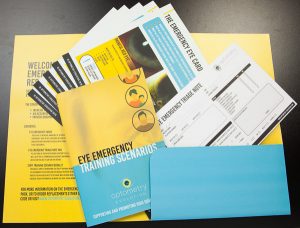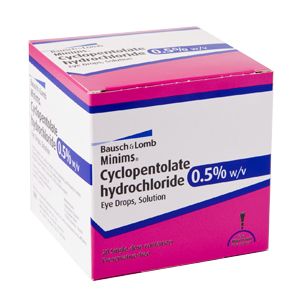In this latest article I want to give an overview of the topic of cycloplegic refraction. Hopefully this will provide some tips on when you might consider performing this technique and how to use the results to prescribe.
CET – you can now do the Cycloplegic Refraction Review on our CET HUB and complete the quiz to gain a GOC CET Point. Just click on this link: https://www.optometry-evolution.com/online-cet-hub/
I have worked for a number of years doing paediatric eye clinics in the hospital alongside orthoptic and ophthalmology colleagues. The optometry input in these clinics is usually to gain as accurate a refraction as possible, prescribe the appropriate spectacles in relation to the child’s age and binocular status, and to examine the health of the eyes. The majority of kids seen are those picked up as four year olds in pre-school screening, however many are much younger, so you have to be adaptable in your technique and how you prescribe.
Hopefully this article will draw on some of these experiences and give some practical advice in this area, based upon what I have found to work.
We will consider the situations where carrying out a cycloplegic refraction is indicated, some practical advice in performing this technique and finally what to do with the result and considerations on prescribing.
Why we should consider carrying out a cycloplegic refraction?
There are several situations where performing this is technique is incredibly useful and in some cases vital. As a general rule any young kid who is still in the visual development phase, who is showing signs of reduced vision or in particular amblyopia and/or strabismus, this really needs to be performed. Kids showing a significant degree of hyperopia or astigmatism may also benefit from cyclo retinoscopy in order to measure the full extent of this prescription. A fairly low threshold should also be kept for kids who have a strong family history of amblyopia or significant refractive error in early childhood.
- To gain a view of the fundus
- Any young kid suspected of significant hyperopia or astigmatism
- Young children with suspected poor vision in one or both eyes
- Suspect strabismus or large phoria
- Any case of suspected amblyopia
- Children with strong family history of childhood visual problems
- Children or adults with learning or communication difficulties
- Older children experiencing headaches
- Unexplained reduced vision
This list may not be exhaustive but hopefully gives a sense of most situations when cycloplegic refraction can be really useful and in some cases vital in order to achieve best management for the patient.
Technique
A PDF download of the technique involved can be downloaded here and kept for reference. In general you want to work as quickly and accurately as possible once the child has been cycloed. You may only have a short period of co-operation if it is a young kid, so use broad steps with the trial lenses and try to bracket in on the result as quickly as possible. Be prepared to adapt your technique so you are measuring on visual axis.
Also in general, clear communication is vital in doing this technique. Explaining clearly to the patient’s parents why this technique is indicated, what is involved and what to expect in terms of the effects of cyclo drops is really important. Also clear communication and a good calm manner with the child involved is crucial. You ideally want to talk them through the process calmly and not create too much excitement around getting the eyedrops in.
How to prescribe
This is an area which is sometimes open to debate between clinicians, but I will describe what works well for me. The kids I refract are followed up by orthoptists to check their visual progress and control of strabismus, so this provides a very good feedback loop and opportunity to make adjustments. Sometimes ‘full-plus’ has been prescribed in order to control a convergent squint, but perhaps the child simply can’t tolerate the spectacles and you temporarily reduce the prescription, or vice versa. The point is that you have to have a means to follow up these kids and be prepared to make adjustments.
The first and perhaps most important point to make here is to always write down what your retinoscopy result is for each eye, before you adjust it by any factor to arrive at a prescription. It means that the next person reviewing the patient, or the hospital if you have referred them can see what this baseline retinoscopy is and how you have derived the Rx.
The amount to prescribe then really depends on the binocular status. The points below give some guidance on this. Essentially you want to prescribe ‘full-plus’ in any child with a convergent strabismus which means just removing your working distance from the retinoscopy result.
- Exophoric or orthophoric – remove 3.00DS from Ret result
- Large Esophoria – remove 2.00 to 2.50DS from Ret result
- Converegent strabismus – remove 1.50DS from Ret result
In cases of astigmatism, I tend to prescribe the full amount of cyl so that the vision can start to develop more normally. This can be a slightly slower process than in straightforward hyperopes.
Myopia prescribing involves a bit more judgement. I don’t always prescribe the retinoscopy with the full 3.00 removed as this often results in a higher myopic correction than their unaided vision suggests. I therefore use a bit of judgement and prescribe to a degree that is in keeping with the unaided vision and review their visual progress. The other option in this situation is to bring the child back for a vision test with trial lenses in to get a feel for what level to prescribe at, and if possible do some basic subjective testing.
In general any child with suspect strabismus and/or amblyopia, or where you have concerns regarding their visual development, really warrants referral for orthoptic input and management. However from a community optometry point of view, you can be doing the child a good service by picking up that they are are at risk of amblyopia and/or strabismus and prescribing spectacles from your refraction in order to start them on the path of better visual development. This done in tandem with a referral to the local orthoptic department with clear information is really helpful.
If there is no evidence or risk of amblyopia then make the appropriate arrangement to review the child in practice – usually 2 or 3 months after spectacle wear has commenced. Again be prepared to change the prescription or to refer if any problems are encountered.
Clear communication also comes into the prescribing and dispensing end of the process. Consider how much the child needs to wear the spectacles – usually full-time if any amblyopia or strabismus involved, and guide the parents and child clearly on this.
Hopefully this is a useful summary of this topic. Again other practitioners may have different approaches, but the above is what I have found to work well, with good ongoing feedback from my orthoptic colleagues. As always any feedback and comments are welcome.
Thank you.
Stan



